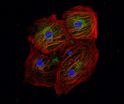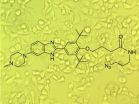(Press-News.org) DURHAM, N.C. – A snapshot of patients who required care at Duke University Hospital during this year's flu season shows that those who had not been vaccinated had severe cases and needed the most intensive treatment.
In an analysis of the first 55 patients treated for flu at the academic medical center from November 2013 through Jan. 8, 2014, Duke Medicine researchers found that only two of the 22 patients who required intensive care had been vaccinated prior to getting sick.
The findings were published online in Monday, Feb. 10, 2014, in the American Journal of Respiratory and Critical Care Medicine.
"Our observations are important because they reinforce a growing body of evidence that the influenza vaccine provides protection from severe illness requiring hospitalizations," said lead author Cameron Wolfe, M.D., assistant professor of medicine at Duke. "The public health implications are important, because not only could a potentially deadly infection be avoided with a $30 shot, but costly hospitalizations could also be reduced."
Wolfe said this year's flu season was marked by hospitalizations of previously healthy young people, with a median age of 28.5 years. Among those who were hospitalized at Duke, 48 of the 55 were infected with the H1N1 virus that caused the 2009 pandemic. That outbreak also hit young adults particularly hard.
"We observed a high percentage of hospitalized patients for influenza requiring ICU level care, which appears higher than observed in our hospital during the 2009 pandemic flu season," said co-author John W. Hollingsworth, M.D., associate professor of medicine at Duke. "It remains unclear whether the high rate of ICU admissions represents a diagnosis bias or whether the severity of illness being caused by the current H1N1 virus is higher."
Of the 33 patients admitted to regular wards rather than the ICU at Duke University Hospital, only eleven had been vaccinated; most of those were immune compromised, chronically ill, or were on a medication that weakened the vaccine's protection.
The study also echoes other studies that have highlighted problems with a rapid test for influenza. Wolfe said 22 of the patients treated at Duke University Hospital had been given a rapid influenza test that came up negative for flu, but they were actually positive when tested by other methods. As a result, they had not received anti-viral medications that might have eased flu symptoms had they been taken early.
"Together, our observations during this influenza season support a high prevalence of the H1N1 virus affecting young adults and requiring ICU care, high false negative rates of rapid flu tests, and delay in starting antiviral treatment," Wolfe said. "Added to the finding of very low vaccination rates among both hospitalized and ICU admissions, our observations support previous findings that vaccination reduces the severity of disease and vaccinations should be encouraged as recommended by the U.S. Centers for Disease Control and Prevention."
INFORMATION:
In addition to Wolfe and Hollingsworth, study authors include J. Catania, L.G. Que and J.A. Govert. END
Young, unvaccinated adults account for severest flu cases
2014-02-10
ELSE PRESS RELEASES FROM THIS DATE:
Researchers discover immune signature that predicts poor outcome in influenza patients
2014-02-10
(Memphis, Tenn. – February 10, 2014) St. Jude Children's Research Hospital scientists have identified a signature immune response that might help doctors identify which newly diagnosed influenza patients are most likely to develop severe symptoms and suffer poor outcomes. The findings also help explain why infants and toddlers are at elevated risk for flu complications. The research appears in the upcoming issue of the American Journal of Respiratory and Critical Care Medicine.
The discovery came after investigators tracked flu infections for 28 days in 84 individuals ...
How do polar bears stay warm? Research finds an answer in their genes
2014-02-10
BUFFALO, N.Y. — In the winter, brown and black bears go into hibernation to conserve energy and keep warm.
But things are different for their Arctic relative, the polar bear. Within this high-latitude species, only pregnant females den up for the colder months.
So how do the rest survive the extreme Arctic winters?
New research points to one potential answer: genetic adaptations related to the production of nitric oxide, a compound that cells use to help convert nutrients from food into energy or heat.
In a new study, a team led by the University at Buffalo reports ...
Experimental care program keeps people with dementia at home longer, study shows
2014-02-10
An 18-month pilot program that brought resources and counselors to elderly Baltimore residents with dementia and other memory disorders significantly increased the length of time they lived successfully at home, according to Johns Hopkins researchers. Staying at home was a clear preference for most of those who participated in the study.
"The project demonstrated that we were able to help such people age in place without sacrificing their quality of life," says study leader Quincy Miles Samus, Ph.D., an assistant professor of psychiatry and behavioral sciences at the ...
Research reveals the give and take of urban temperature mitigating technologies
2014-02-10
TEMPE, Ariz. – Life in a warming world is going to require human ingenuity to adapt to the new realities of Earth. Greenhouse-gas induced warming and megapolitan expansion are both significant drivers of our warming planet. Researchers are now assessing adaptation technologies that could help us acclimate to these changing realities.
But how well these adaptation technologies – such as cool roofs, green roofs and hybrids of the two – perform year round and how this performance varies with place remains uncertain.
Now a team of researchers, led by Matei Georgescu, ...
The genetic origins of high-altitude adaptations in Tibetans
2014-02-10
Genetic adaptations for life at high elevations found in residents of the Tibetan plateau likely originated around 30,000 years ago in peoples related to contemporary Sherpa. These genes were passed on to more recent migrants from lower elevations via population mixing, and then amplified by natural selection in the modern Tibetan gene pool, according to a new study by scientists from the University of Chicago and Case Western Reserve University, published in Nature Communications on Feb. 10.
The transfer of beneficial mutations between human populations and selective ...
Study involving twin sisters provides clues for battling aggressive cancers
2014-02-10
CINCINNATI – Analyzing the genomes of twin 3-year-old sisters – one healthy and one with aggressive leukemia – led an international team of researchers to identify a novel molecular target that could become a way to treat recurring and deadly malignancies.
Scientists in China and the United States report their findings online Feb. 9 in Nature Genetics. The study points to a molecular pathway involving a gene called SETD2, which can mutate in blood cells during a critical step as DNA is being transcribed and replicated.
The findings stem from the uniquely rare opportunity ...
Genome editing goes hi-fi
2014-02-10
SAN FRANCISCO, CA—February 9, 2014—Sometimes biology is cruel. Sometimes simply a one-letter change in the human genetic code is the difference between health and a deadly disease. But even though doctors and scientists have long studied disorders caused by these tiny changes, replicating them to study in human stem cells has proven challenging. But now, scientists at the Gladstone Institutes have found a way to efficiently edit the human genome one letter at a time—not only boosting researchers' ability to model human disease, but also paving the way for therapies that ...
Cochlear implants -- with no exterior hardware
2014-02-10
Cochlear implants — medical devices that electrically stimulate the auditory nerve — have granted at least limited hearing to hundreds of thousands of people worldwide who otherwise would be totally deaf. Existing versions of the device, however, require that a disk-shaped transmitter about an inch in diameter be affixed to the skull, with a wire snaking down to a joint microphone and power source that looks like an oversized hearing aid around the patient's ear.
Researchers at MIT's Microsystems Technology Laboratory (MTL), together with physicians from Harvard Medical ...
Scientists invent advanced approach to identify new drug candidates from genome sequence
2014-02-10
JUPITER, FL—February 9, 2014—In research that could ultimately lead to many new medicines, scientists from the Florida campus of The Scripps Research Institute (TSRI) have developed a potentially general approach to design drugs from genome sequence. As a proof of principle, they identified a highly potent compound that causes cancer cells to attack themselves and die.
"This is the first time therapeutic small molecules have been rationally designed from only an RNA sequence—something many doubted could be done," said Matthew Disney, PhD, an associate professor at TSRI ...
Fight or flight? Vocal cues help deer decide during mating season
2014-02-10
Previous studies have shown that male fallow deer, known as bucks, can call for a mate more than 3000 times per hour during the rut (peak of the mating season), and their efforts in calling, fighting and mating can leave them sounding hoarse.
In this new study, published today (10 February) in the journal Behavioral Ecology, scientists were able to gauge that fallow bucks listen to the sound quality of rival males' calls and evaluate how exhausted the caller is and whether they should fight or keep their distance.
"Fallow bucks are among the most impressive vocal athletes ...





